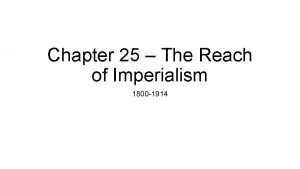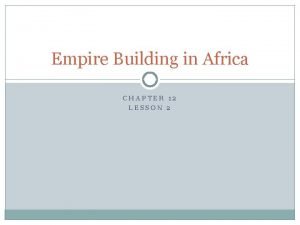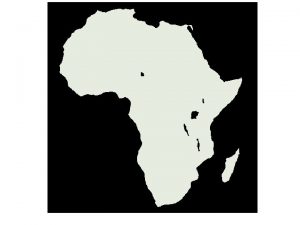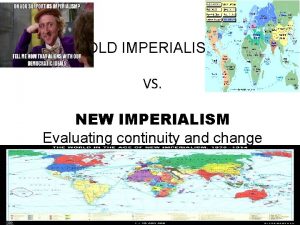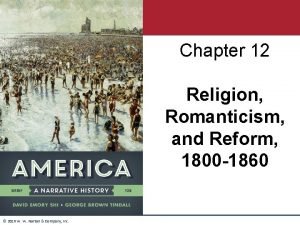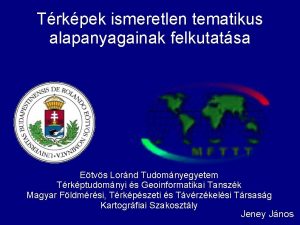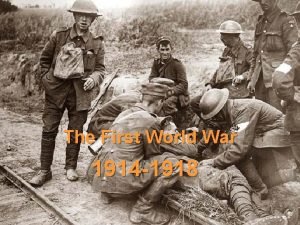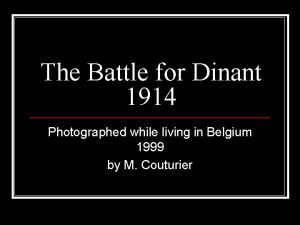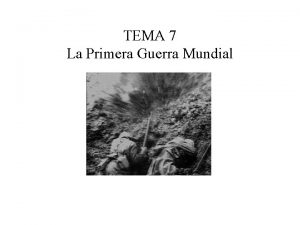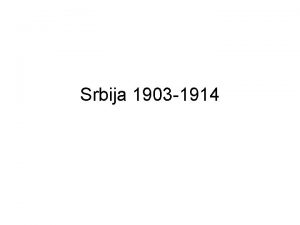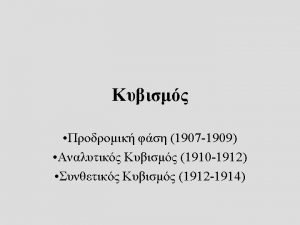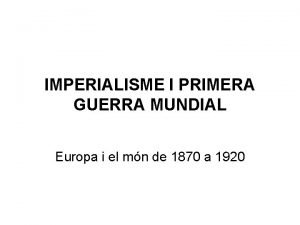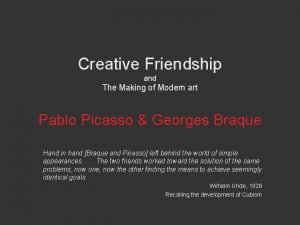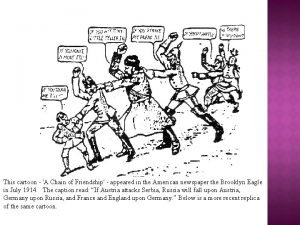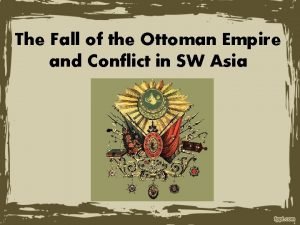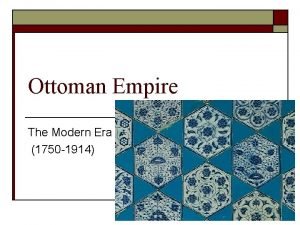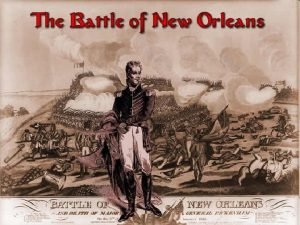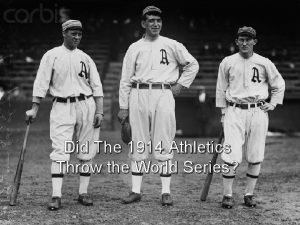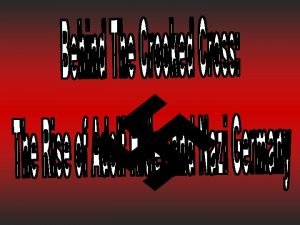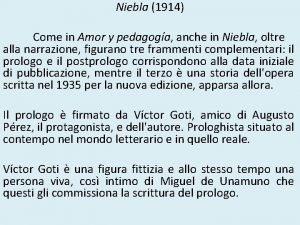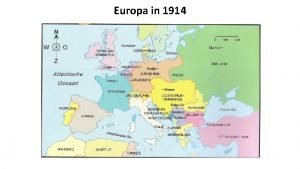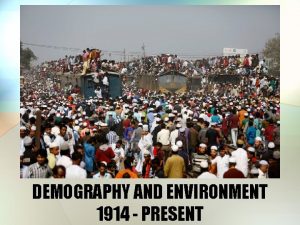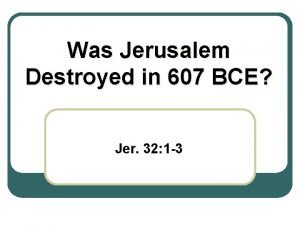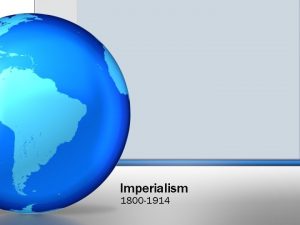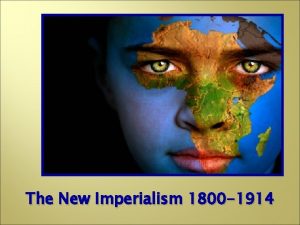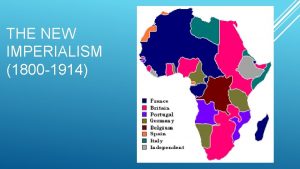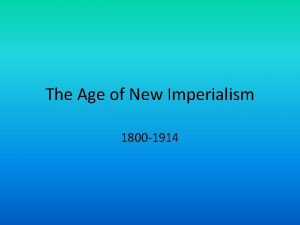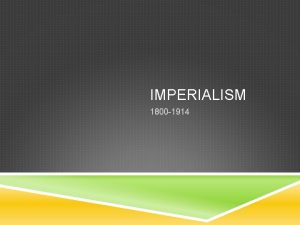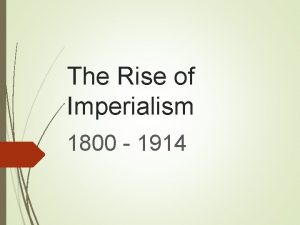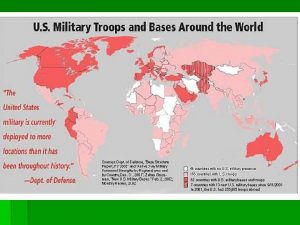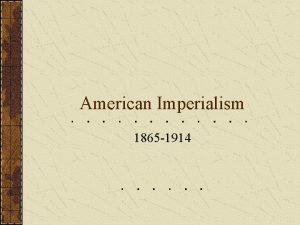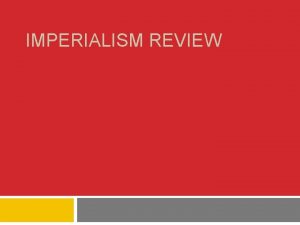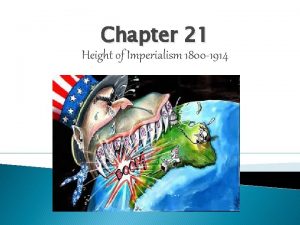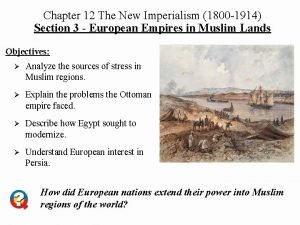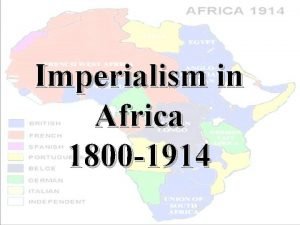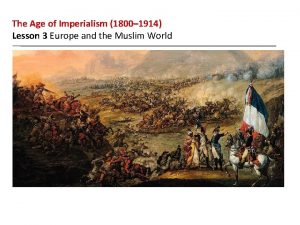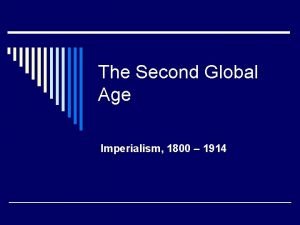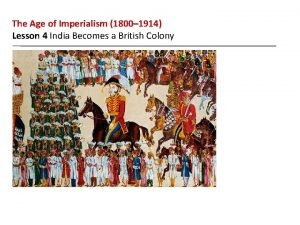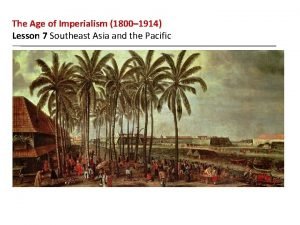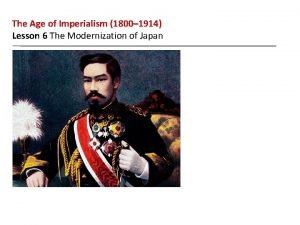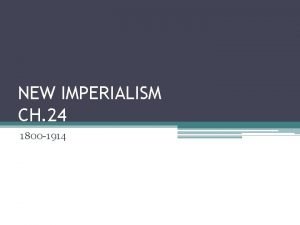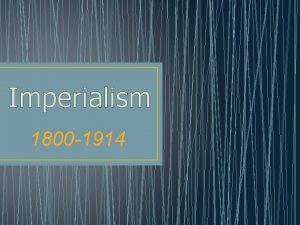Chapter 25 The Reach of Imperialism 1800 1914































- Slides: 31

Chapter 25 – The Reach of Imperialism 1800 -1914

Lesson 1 – Colonial Rule in Southeast Asia

What is imperialism? Control over another territory, typically against its will – a control that is either political, militarily, economic or cultural Social Darwinism was a major part of the philosophy – racism What was the nature of earlier imperialism? Typically, most earlier colonialism was the establishment of trading coastal cities to participate in regional trade. Purpose of this new imperialism? The need for natural resources and new markets Prestige – countries were considered more powerful if they had colonies Religious or civilizing responsibility towards others

Gunboat diplomacy – the act of a superior naval force intimidating another, typically one not as strong Military advancements were a type of new technology to help in colonization along with: Communication advancements (i. e. telegraph) Medical advancements (i. e. : anti-Malaria drugs)


Imperialism – Direct v. Indirect Rule For most of its history, the Dutch were not interested in spreading its culture – only in doing business (indirect rule). They stayed on the coast, allowing local rulers to remain in charge in the interior of the islands. Britain’s rule in India was complete. Like the French in Indochina (Vietnam, Laos and Cambodia), British India was ruled solely by British officials (direct rule).

Imperialism – Export of Raw Materials Rubber extraction in Vietnam Colonies were used for raw materials and then sold back finished or manufactured products. Cotton in India Tea in Sri Coffee in Indonesia

Most early resistance in Southeast Asia against Europeans were without focus nor success: The French were able to put down the Can Vuong in Vietnam. Saya San Rebellion in Burma was equally unsuccessful but inspired future uprisings.

Lesson 2 – Empire Building in Africa

Traditionally, Europeans were content to control ports and let Africans rule themselves but that changed after 1880: France made up the largest part of Western Africa Britain controlled key areas such as Nigeria, the Gold Coast (modernday Ghana) and Sierra Leone. Germany, Spain and the United States controlled small areas. Major raw materials from the region: peanuts hinds timber palm oil

Egypt had been modernized in some ways by Muhammad Ali after establishing independence for the country. The emergence of a canal connecting the Mediterranean Sea and Indian Ocean brought the British in. British control of the region (pink above) led to a revolt in the 1880 s by the Mahdis. The French (blue) were the other major power in North Africa, controlling modern-day Algeria and Tunisia. Ottoman control (maroon) in the region would eventually be replaced by the Italians.

Belgian Congo was one of the worst examples of European abuses in Africa (or anywhere else for that matter). King Leopold II, after the work and explorations of David Livingstone and Henry Stanley, eagerly took control of central Africa – centered on the Congo River. Area was not a colony – it was personal property of the king. So horrible was the king’s treatment of Congolese, the government took over the colony. It is estimated that Leopold’s practices led to the death of half the Congo’s population (10 m). Belgium held onto the Congo until 1960.

The Berlin Conference in 1884 was designed to recognize claims European countries had – particularly Germany and Britain – in Africa. All this colonial business is a sham but we need it for the elections. Otto von Bismarck

Modern-day South Africa was settled and controlled by two different groups: The British controlled the southern part – Cape Colony Boers or Afrikaners (descendants of Dutch farmers) hated the British and created three republicans to the northeast – Transvaal, Natal and Orange Free State. Boers constantly battled with the Zulus, led by Shaka.

When Cape Colony governor Cecil Rhodes found gold and diamonds in the Boer areas and pushed into their regions, it triggered the Boer War. 1899– 1902 – The Boer War was fought, becoming vicious and inhumane. 20, 000 Boer women and children died of starvation in British camps. The defeat of the Boer led to the creation of the Union of South Africa in 1902.

The world is nearly all parcelled out, and what there is left of it is being divided up, conquered and colonised. To think of these stars that you see overhead at night, these vast worlds which we can never reach. I would annex the planets if I could; I often think of that. It makes me sad to see them so clear and yet so far. Cecil Rhodes

Impact of Imperialism on Africa: all British indirect rule maintained many local customs and traditions but they made decisions in reality. Indirect rule kept African elite in charge with little chance of non-elite people to break into government or influential positions. Direct rule Europeans – like France – insisted their culture be observed. European-drawn borders put conflicting tribes in same country – fostering violence. Most African leaders were pro-western but like other Africans, resented European presence.

Lesson 3 – British Rule in India

Sepoys were Indian soldiers used by the East India Company. Revolt began upon a rumor that the British were using pig and cow fat to grease the weapons used by the Sepoys. For Muslim Indians, the pig was taboo. For Hindu Indians, the cow was sacred. Some Sepoy were arrested for mutiny for refusing to take up the weapons – led to a widespread revolt that killed men, women and children. The Sepoy Mutiny (1857) Religious differences kept the Sepoys from working together. Massacres were recorded on both sides. Impact? British government took control over India and made it a proper colony.

British rule in India was overseen by a viceroy (governor) with about 3, 500 officials to rule 300 million people. Impacts of British direct-rule? New school system (served only upper elite) Law and order in a fractious country Banned certain practices like suttee Destruction of local businesses (particularly, the textile industry) Zamindars were used to collect taxes – led to corruption (first seen by Akbar during the Mogul Dynasty) Well-meaning Brits were offset by racism and superior attitudes

Mohandas Gandhi became a galvanizing force of the INC and the major symbol of Indian independence. The first Indian National Congress (INC) – Mumbai, 1885 While some wanted revolution, many wanted reform and to participate in the government with the British. Opinions also were divided on religious grounds between Hindus and Muslims.

Gangadhar Tilak Colonial Indian Culture: British held wide-spread disrespect of India, its history, traditions and values. British also responsible for educational, literary revival of India and its history. The printed word became a favored expression of Indian pride by Indians. Kesari – Newspaper edited by Gangadhar Tilak who made it clear his distrust and dislike of the British. Rabindranath Tagore – writer, poet and activist who set up an international university. He worked hard to preach and instill Indian pride while struggling with lovehate relationship with British. Rabindranath

Of course man is useful to man, because his body is a marvellous machine and his mind an organ of wonderful efficiency. But he is a spirit as well, and this spirit is truly known only by love. When we define a man by the market value of the service we can expect of him, we know him imperfectly. With this limited knowledge of him it becomes easy for us to be unjust to him and to entertain feelings of triumphant selfcongratulation when, on account of some cruel advantage on our side, we can get out of him much more than we have paid for. But when we know him as a spirit we know him as our own. We at once feel that cruelty to him is cruelty to ourselves, to make him small is stealing from our own humanity. . . Rabindranath Tagore

Lesson 4 – Imperialism in Latin America

Spanish-American War (1898) Jose Marti was influential in getting the U. S. interested in the uprising in Cuba – after the war, Cuba was overseen by the U. S. until 1901. As a result of the U. S. victory over Spain (Treaty of Paris of 1898), the Americans picked up: Puerto Rico Guam in Philippines (received its independence 1946)

The Panama Canal Theodore Roosevelt was instrumental in the independence of Panama from Columbia and with the building of the Panama Canal which the Americans controlled until 1977.

U. S. involvement in other parts of Latin America was an extension of the Monroe Doctrine. Dollar diplomacy – America’s declaration that they will intervene the affairs of countries in Latin America to protect economic interests.

The Mexican Revolution – the Problem Porfirio Diaz was the dictator of Mexico from 1877 to 1911. He was largely supported by the landed-elite, the military, foreign investors and the Catholic Church. He stayed in power by pleasing these groups – usually at the expense of the peasant farmer and other ordinary Mexicans. Wages were dropping and very few ordinary Mexicans owned land – nor were they really allowed to.

The Mexican Revolution – the Troublemakers Pancho (Francisco) Villa was a bandit that operated in northern Mexico and who served as a permanent thorn in the side of the Mexican government. He felt Madero was not doing enough for the people. Francisco Madero was a liberal landowner who, once he took power, tried to bring significant reforms but ultimately failed. Often considered the true spirit of the revolution and from southern Mexico, Emiliano Zapata pushed for land re-distribution and greater opportunities for landless Mexicans. He was willing to work with Madero but would not disarm his followers.

The Mexican Revolution – the Results The 1917 constitution included many of the ideas of the revolution: Political and land reform All males could vote Unions for workers Limit on foreign investors As for the revolutionaries, Francisco Madero was assassinated in 1913, Emiliano Zapata in 1919 and Pancho Villa in 1923.

How did industrialization and prosperity change Latin American societies? Exports increased out of Latin America to the rest of the world (wheat, beef, coffee, bananas and sugar). Landed elite still dominated rural regions though the export business built up a middle class (who pushed for reforms in politics, economy and society). Increase in European immigration to Latin America. Increase in urbanization.
 Chapter 25 lesson 4 imperialism in latin america
Chapter 25 lesson 4 imperialism in latin america Imperialism map 1914
Imperialism map 1914 Empire building in africa summary
Empire building in africa summary Causes of new imperialism
Causes of new imperialism Old vs new imperialism
Old vs new imperialism Chapter 12: religion, romanticism, and reform, 1800–1860
Chapter 12: religion, romanticism, and reform, 1800–1860 In 1914 who controlled the shaded areas on the map
In 1914 who controlled the shaded areas on the map Európa térképe 1914-ben
Európa térképe 1914-ben Colonial empires 1914
Colonial empires 1914 Dinant 1914
Dinant 1914 Conclusiones de la segunda guerra mundial
Conclusiones de la segunda guerra mundial Srbija od 1903 do 1914
Srbija od 1903 do 1914 Picasso ma jolie 1914
Picasso ma jolie 1914 Imperialisme i primera guerra mundial
Imperialisme i primera guerra mundial Hrvatska književnost od 1929 do 1952
Hrvatska književnost od 1929 do 1952 Ekspresionizam u hrvatskoj književnosti ppt
Ekspresionizam u hrvatskoj književnosti ppt Picasso ma jolie 1914
Picasso ma jolie 1914 Colonial empires 1914
Colonial empires 1914 A chain of friendship cartoon analysis
A chain of friendship cartoon analysis Ottoman empire 1914
Ottoman empire 1914 Ottoman empire 1914
Ottoman empire 1914 Moda 1920
Moda 1920 We fired our guns and the british
We fired our guns and the british Braves
Braves 1914 1918
1914 1918 The courtyard of the old residency in munich (1914)
The courtyard of the old residency in munich (1914) Protagonista niebla
Protagonista niebla La treve de noel 1914 film
La treve de noel 1914 film Europa in 1914
Europa in 1914 World population in 1914
World population in 1914 Destruction of jerusalem 607
Destruction of jerusalem 607 Born on may 12, 1914, in dallas, texas.
Born on may 12, 1914, in dallas, texas.
